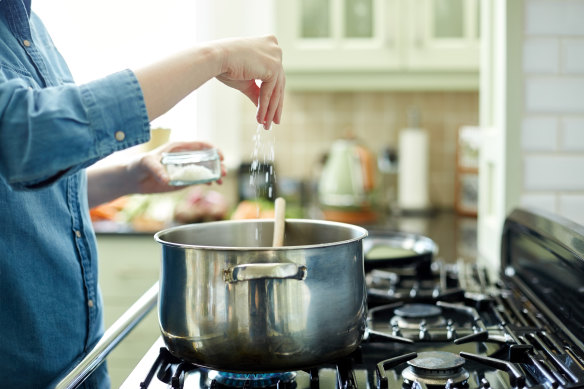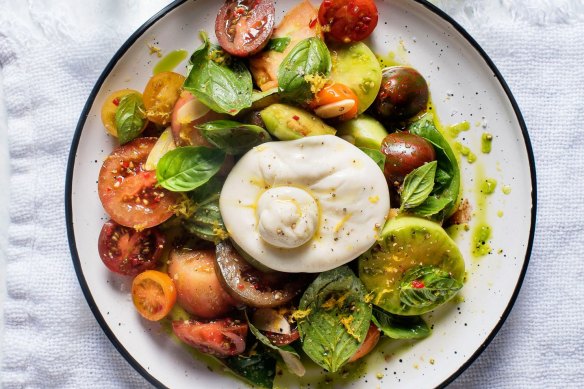Embrace your inner salt bae with these essential pro seasoning tips
In the first of a new column solving modern cooking and eating out dilemmas, Alice Zaslavsky teaches us how and when to add salt to a dish to change it from bland to ‘BAM!’
It’s no wonder that the technical term for adding salt to something is “seasoning” – it takes a seasoned professional or home cook with keen know-how to recognise when and how to do it properly.
Understanding the properties of salt and what, aside from flavour, it can do for a dish or ingredient, can also help to determine when to deploy salt into your cooking.

According to the oracle of food science, Harold McGee, salt strengthens the impression of accompanying aromas and suppresses the sensation of bitterness.
Salt also draws moisture out of living cells – plant and protein – via osmosis, which is why it’s used both to break down the cell structure of vegetables such as eggplant to make it easier to fry (while mitigating any natural bitterness), and helps denature the proteins in dishes like cured egg yolks and gravlax.

Start with salt
Seasoning at the start of cooking means salt will be drawn into the heart of an ingredient to help flavour the dish more evenly. The following common cooking scenarios are best with kick-off salting:
- When cooking starchy ingredients such as pasta, rice and grains. Season the water generously by pinching all five fingers together.
- When blanching and boiling veg, properly seasoned water means better-seasoned veg. Remember to salt the water you boil your potatoes in for a creamier-tasting mash.
- If soaking dried beans or legumes, salt the soaking water liberally. To help with digestion, discard this soaking water and rinse the beans before cooking – but salt the cooking water with a five-finger pinch.
- When cooking steak, season the pan, not the meat. Heat the dry pan and add a three-finger pinch of salt flakes across its surface. When the salt starts to crackle in the pan like popcorn, the pan is hot enough to add the oiled (but not seasoned) steak. The hot salt will stick to the meat, season it as it cooks, and help form a crust. If you insist on pre-seasoning, do so at least an hour before cooking to allow the moisture to go through its full cycle of drawing out of the meat and then back in again.
- For roasts, salting can be done up to a day in advance. If you want an extra crackle on everything from roast pork to crisp-skinned chook, rub it with a four-finger pinch of salt then leave the meat uncovered in the fridge overnight to dry out before roasting.
- For braises, soups and stews, under-season at the start, as the long cooking time will intensify the saltiness. A three-finger pinch should do it. You can always taste and correct it at the end.
- Salad dressing is best seasoned before adding fat, as salt is water-soluble. This means combining the salt and pepper with the vinegar or lemon juice before the olive oil goes in.

Add salt later
Here’s what’s best seasoned further along:
- When sauteing or stir-frying veg, salt once everything’s cooked and before the heat’s off to season each piece evenly. Splashing in a little liquid as you season will help to deglaze the pan and allow the salt to dissolve and absorb better, too. Gilbert Lau (founder of Flower Drum/Lau’s Family Kitchen) taught me to add a scant pinch of sugar at the same time to fake the ripest, most flavoursome greens.
- When making dough – especially the kind that needs leavening – hold the salt until after the yeast’s foamy. Salt is antimicrobial and reduces yeast activity (less important for instant yeast, I should add). If you forget to season your dough, you can add it once the dough is formed. Dissolve the salt in a little water (to help it diffuse more evenly) and knead it in.
- Eggs for scrambling and omelettes will cook faster and more evenly if you season them once beaten. Don’t add salt to the mix until after the pan’s heating, as they’ll start to cure.
- For salted caramel, add the salt once the caramel’s already made. Adding it any sooner will cause the sugars to crystallise.
- Delicate ingredients are best with a swifter season just before serving. Tomatoes behave best when seasoned 10 minutes before showtime. The same can be said of fruits such as melon, pineapple and the like, which love a sprinkle of salt but not enough time to start leaching moisture.

Finishing strong
Salt’s physical shape also determines how it’s experienced on the tongue, so a flatter, flaked or pyramid-shaped salt is perfect for finishing dishes so that each bite is met with bits of brininess on the tongue.
If you’ve seasoned at the start, it pays to finish with another flaky flutter just before serving. Each person’s palate varies, so “season to taste” means to your own, or slightly under. Then you can have flaky salt on the table for others to adjust to their liking.
When eating out, or in, for that matter, remember to taste a dish before adding more salt at the table – it’s just good eaters’ etiquette.
Welcome to Ask Alice
Ask Alice is our new guide to cooking, entertaining and eating out from Alice Zaslavsky. Zaslavsky is the award-winning author of international best-seller and James Beard finalist In Praise of Veg, kids’ fun food bible Alice’s A to Z, and cooking confidence unlocker The Joy of Better Cooking. She is the long-time culinary correspondent for ABC News Breakfast and ABC Radio, and host of Saturday Breakfast on ABC Radio Melbourne.
Send questions and conundrums to her at alice@aliceinframes.com
The best recipes from Australia's leading chefs straight to your inbox.
Sign up